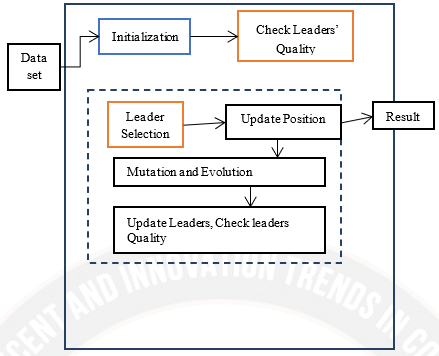MOCF: A Multi-Objective Clustering Framework using an Improved Particle Swarm Optimization Algorithm
Main Article Content
Abstract
Traditional clustering algorithms, such as K-Means, perform clustering with a single goal in mind. However, in many real-world applications, multiple objective functions must be considered at the same time. Furthermore, traditional clustering algorithms have drawbacks such as centroid selection, local optimal, and convergence. Particle Swarm Optimization (PSO)-based clustering approaches were developed to address these shortcomings. Animals and their social Behaviour, particularly bird flocking and fish schooling, inspire PSO. This paper proposes the Multi-Objective Clustering Framework (MOCF), an improved PSO-based framework. As an algorithm, a Particle Swarm Optimization (PSO) based Multi-Objective Clustering (PSO-MOC) is proposed. It significantly improves clustering efficiency. The proposed framework's performance is evaluated using a variety of real-world datasets. To test the performance of the proposed algorithm, a prototype application was built using the Python data science platform. The empirical results showed that multi-objective clustering outperformed its single-objective counterparts.
Article Details
References
Rachsuda Jiamthapthaksin, Christoph F. Eick and Ricardo Vilalta. (2010). A Framework for Multi-objective Clustering and its Application to Co-location Mining, p1-12.
Khan, S. S., & Ahmad, A. (2013). Cluster centre initialization algorithm for K-modes clustering. Expert Systems with Applications, 40(18), 7444–7456.
Abubaker, A., Baharum, A., & Alrefaei, M. (2015). Automatic Clustering Using Multi-objective Particle Swarm and Simulated Annealing. PLOS ONE, 10(7), p1-23.
Gong, C., Chen, H., He, W., & Zhang, Z. (2017). Improved multi-objective clustering algorithm using particle swarm optimization. PLOS ONE, 12(12), p1-19.
Zhang, Y., Gong, D., & Cheng, J. (2017). Multi-Objective Particle Swarm Optimization Approach for Cost-Based Feature Selection in Classification. IEEE/ACM Transactions on Computational Biology and Bioinformatics, 14(1), 64–75.
Li, X., & Wong, K.-C. (2018). Evolutionary Multiobjective Clustering and Its Applications to Patient Stratification. IEEE Transactions on Cybernetics, 1–14.
Poli, R., Kennedy, J., & Blackwell, T. (2007). Particle swarm optimization. Swarm Intelligence, 1(1), 33–57.
Dai, H., & Sheng, W. (2019). A Multi-objective Clustering Ensemble Algorithm with Automatic k-Determination. 2019 IEEE 4th International Conference on Cloud Computing and Big Data Analysis (ICCCBDA). P1-5.
Pizzuti, C., & Socievole, A. (2019). Multiobjective Optimization and Local Merge for Clustering Attributed Graphs. IEEE Transactions on Cybernetics, 1–13.
XIAOLIN HE, XIUWEN FU AND YONGSHENG YANG . (2019). Energy-Efficient Trajectory Planning Algorithm Based on Multi-Objective PSO for the Mobile Sink in Wireless Sensor Networks. IEEE. 7, p1-14.
Kajol Khatri, & Dr. Anand Sharma. (2022). A Study on Lightening Asynchronous Pipeline Controller for Reusable Delay Path Synthesis. Acta Energetica, (03), 29–34. Retrieved from http://actaenergetica.org/index.php/journal/article/view/474
Nooraddin Dabiri , Mohammad. J. Tarokh AND Mahdi Alinaghian. (20147). A new mathematical model for bi-objective inventory routing problem with step cost function: A MOPSO solution approach. Elsevier. . (.), p302-318.
Rohit Gavval and Vadlamani Ravi. (2020). Clustering Bank Customer Complaints on Social Media for Analytical CRM via Multi-objective Particle Swarm Optimization. Springer, p1-33.
Oshin Dhiman, & Dr. Anand Sharma. (2022). Incorporation of Booster in Carbon Interconnects for High-Speed Integrated Circuits. Acta Energetica, (03), 22–28. Retrieved from http://actaenergetica.org/index.php/journal/article/view/473
Shiwei Yu, Shuhong Zheng, Siwei Gao and Juan Yang. (2017). A multi-objective decision model for investment in energy savings and emission reductions in coal mining . Elsevier, P335-347.
Biswa Mohan Sahoo, Tarachand Amgoth and Hari Mohan Pande. (2020). Particle swarm optimization based energy e?cient clustering and sink mobility in heterogeneous wireless sensor network . Elsevier, P102-237.
Caro Fuchs, Simone Spolaor, Marco S. Nobile and Uzay Kaymak. (2019). A Swarm Intelligence Approach to Avoid Local Optima in Fuzzy C-Means Clustering, P1-6.
Haibo Yu . (2017). Clustering-Based Evolution Control for SurrogateAssisted Particle Swarm Optimization . IEEE, P1-6.
Chao Guana, Zeqiang Zhang, Silu Liu, Juhua Gonga. (2019). Multi-objective particle swarm optimization for multi-workshop facility layout problem . Elsevier, P32-48.
A. A. Mousa, M. A. El-Shorbagy and M. A. Farag. (2017). K-means-Clustering Based Evolutionary Algorithm for Multi-objective Resource Allocation Problems. Appl. Math. Inf. Sci. 11 (6), P1681-1692.
Qureshi, D. I. ., & Patil, M. S. S. . (2022). Secure Sensor Node-Based Fusion by Authentication Protocol Using Internet of Things and Rfid. Research Journal of Computer Systems and Engineering, 3(1), 48–55. Retrieved from https://technicaljournals.org/RJCSE/index.php/journal/article/view/41
Zesong Fei . (2016). A Survey of Multi-Objective Optimization in Wireless Sensor Networks: Metrics, Algorithms and Open Problems. IEEE, P1-38.
https://journals.plos.org/plosone/article?id=10.1371/journal.pone.0188815#references
Joshua D. Knowles and David W. Corne. Approximating the Nondominated Front Using the Pareto Archived Evolution Strategy. Evolutionary Computation, 8(2):149-172, 2000.
Shanthi, D. N. ., & J, S. . (2022). Social Network Based Privacy Data Optimization Using Ensemble Deep Learning Architectures. Research Journal of Computer Systems and Engineering, 3(1), 62–66. Retrieved from https://technicaljournals.org/RJCSE/index.php/journal/article/view/43
Prakash, P. & Janardhan, M. & Sreenivasulu, K. & Saheb, Shaik & Neeha, Shaik & Maloth, Bhav Singh. (2022). Mixed Linear Programming for Charging Vehicle Scheduling in Large-Scale Rechargeable WSNs. Journal of Sensors. 2022. 1-13. 10.1155/2022/8373343.
Yusuf, K., Shuaibu, D. S., & Babale, S. A. (2022). Channel Propagation Characteristics on the Performance of 4G Cellular Systems from High Altitude Platforms (HAPs). International Journal of Communication Networks and Information Security (IJCNIS), 13(3). https://doi.org/10.17762/ijcnis.v13i3.5133 (Original work published December 25, 2021)
Pasha, M. & Pingili, Madhavi & Sreenivasulu, K. & Maloth, Bhav Singh & Saheb, Shaik & Saleh, Alaa. (2022). Bug2 algorithm-based data fusion using mobile element for IoT-enabled wireless sensor networks. Measurement: Sensors. 100548. 10.1016/j.measen.2022.100548.
Maloth, Bhav Singh & Anusha, R. & Reddy, R. & Devi, S.Chaya. (2013). Augmentation of Information Security by Cryptography in Cloud Computing. www.ijcst.com. 4.
Amuda, O. K., Akinyemi, B. O., Sanni, M. L., & Aderounmu, G. A. (2022). A PREDICTIVE USER BEHAVIOUR ANALYTIC MODEL FOR INSIDER THREATS IN CYBERSPACE. International Journal of Communication Networks and Information Security (IJCNIS), 14(1). https://doi.org/10.17762/ijcnis.v14i1.5208 (Original work published April 12, 2022)

